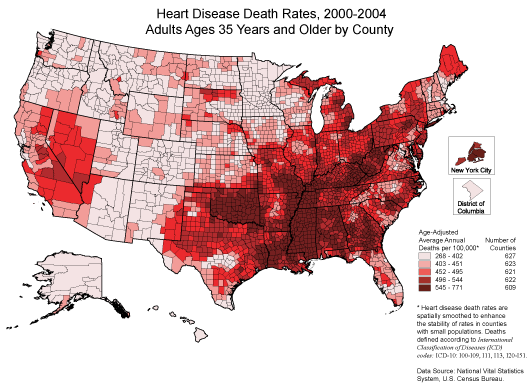 |
|
 |
 |
 |
Fact Sheets and At-a-Glance Reports
Heart Disease Fact Sheet
This document is also available in
Portable
Document Format (PDF–311K).
Learn more about
PDFs.

 Click
HERE to view a larger version
of this map. (PDF 189K) Click
HERE to view a larger version
of this map. (PDF 189K)
*Heart disease death rates are
spatially smoothed to enhance the stability of rates in counties with small
populations. Deaths are defined according to the following
International Classification of Diseases (ICD) codes: ICD-9:
390–398, 402, 404–429; ICD-10: 100–109, I11, I13, 120–151.
Data
Sources: National Vital Statistics System, CDC, and the U.S. Census Bureau.
Heart Disease Facts
- Heart disease is the leading cause of death for women and men in the
United States.*1,2
- In 2003, a total of 685,089 people died of heart disease (51% of
them women), accounting for 28% of all U.S. deaths. The age-adjusted
death rate was 232 per 100,000 population.2
- In the United States, the highest death rates from heart disease are
located primarily in Appalachia, along the southeastern coastal plains,
inland through the southern regions of Georgia and Alabama, and along
the lower Mississippi River Valley. 3
- Heart disease death rates per 100,000 population for the five
largest U.S. racial/ethnic groups are as follows: blacks, 300; whites,
228; Hispanics, 173; American Indian/Alaskan Natives, 160 and Asian and
Pacific Islanders,128.4
- In 2006, heart disease is projected to cost $142.5 billion,
including health care services, medications, and lost productivity.2
- Studies among coronary heart disease patients have shown that 90%
have prior exposure to at least 1 of these heart disease risk factors:
high blood cholesterol or taking cholesterol-lowering drugs, high blood
pressure or taking blood pressure-lowering drugs, current cigarette use,
or clinical report of diabetes.5
___________________________________
* For this fact sheet, the term “heart disease”
refers to the broadest category of “disease of the heart” as defined by
the International Classification of Diseases and used by CDC’s National
Center for Health Statistics. This category includes acute rheumatic
fever, chronic rheumatic heart disease, hypertensive heart disease,
coronary heart disease, pulmonary heart disease, congestive heart
failure, and any other heart condition or disease.
CDC Activities to Reduce the Burden of Heart Disease
CDC's Heart Disease and Stroke Prevention Program
CDC currently funds health departments in 32 states and the District
of Columbia to develop, implement, and evaluate programs that promote
heart-healthy and stroke-free communities; prevent and control heart
disease, stroke, and their risk factors; and eliminate disparities among
populations. These programs emphasize the
use of education, policies, environmental strategies, and systems changes
to address heart disease and stroke in various settings and to ensure
quality of care. For more information, visit www.cdc.gov/dhdsp/state_program/index.htm.
Women and Heart Disease: An Atlas of Racial and Ethnic
Disparities in Mortality and Men and Heart Disease: An Atlas of
Racial and Ethnic Disparities in Mortality
These two publications present an extensive series of national and state
maps depicting disparities in county-level heart disease death rates among
the five largest U.S. racial and ethnic groups. This information can help
health professionals and concerned citizens tailor prevention policies and
programs to communities with the highest death rates for heart disease.
Interactive versions of the atlases are available at
http://www.cdc.gov/dhdsp/maps/.
For More Information
For more information on heart disease, visit the following Web sites.
Return to Top of Page
Resources
- American Heart Association. Heart Disease and Stroke
Statistics—2006 Update. Dallas, Texas: American Heart Association,
2006.
- Hoyert DL, Heron MP, Murphy SL, Kung H. Deaths: Final Data for 2003.
National vital statistics reports; vol 54 no 13. Hyattsville, MD:
National Center for Health Statistics. 2006.
- Centers for Disease Control and Prevention. Heart Disease Death
Rates, 1999–2004: Adults Ages 35 Years and Older, by County. Available
at
http://www.cdc.gov/dhdsp/library/maps/index.htm (please see map
above).
- Centers for Disease Control and Prevention, Health, United States, 2005
with Chartbook on Trends in the Health of Americans. Hyattsville, MD:
National Center for Health Statistics, 2005.
- Greenland P, Knoll MD, Stamler J, Neaton JD, Dyer AR, Garside DB,
Wilson PW. Major risk factors as antecedents of fatal and nonfatal
coronary heart disease events. JAMA 2003;290:891–897.
*Links to non–Federal organizations are provided solely as a service to our users. Links do not constitute an endorsement of any organization by CDC or the Federal Government, and none should be inferred. The CDC is not responsible for the content of the individual organization Web pages found at this link.
Page last reviewed: July 1, 2008
Page last modified: July 1, 2008
Content source: Division for Heart Disease and Stroke
Prevention,
National Center for Chronic Disease Prevention and
Health Promotion |
 |